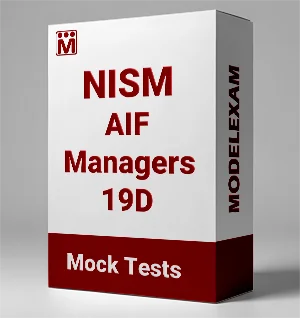NISM Series XIX-D : Category I and II Alternative Investment Fund Managers Certification Examination
NISM Series XIX-D Mock Test
(Free Demo & Premium)

It's Series 19D. 'XIX' is Roman Numeral for 19.
Official name is NISM Series XIX-D: Category I and II Alternative Investment
Fund Managers Certification Examination. Also known as NISM 19D, NISM
XIX-D, AIF Manager (Cat 1 & 2) exam, etc.
This exam creates a common minimum knowledge benchmark for Category I and II AIF
Managers and their investment teams. It focuses on features of AIF products, valuation
norms, governance, performance measurement, taxation, and regulations.
An AIF Manager is a person or entity responsible for managing AIFs (funds investing in
assets outside traditional stocks/bonds like PE, VC, Real Estate, etc.).
- Fund Managers and Investment Professionals of Cat I & II AIFs.
- Compliance Officers and Legal Advisors.
- Trustees and Custodians.
- Senior Management of AIFs.
- Aspiring AIF Managers.
Study Material: Click here for NISM 19D Study Material
Exam Registration: NISM Registration Procedure
Exam Dates: NISM Exam Dates
Assessment Structure
| Total Marks | 100 |
|---|---|
| Total Questions | Multiple Choice [60 x 1 = 60] Case-based [4 cases x 5 marks = 40] |
| Total Duration | 2 Hours |
| Passing Score | 60% |
| Negative Marking | 25% (0.25 mark) |
Syllabus & Weightage
| Unit No. | Unit Name | Weightage |
|---|---|---|
| Unit 1 & 2 | Investments Landscape & Types of Investments | 2% |
| Unit 3 | Alternative Investment Funds in India and its Suitability | 2% |
| Unit 4 | Alternative Investment Funds Ecosystem | 5% |
| Unit 5 | Alternative Investment Fund Structuring | 10% |
| Unit 6 | Fee Structure of AIFs | 10% |
| Unit 7 | Fund Performance and Benchmarking of AIFs | 10% |
| Unit 8 | Legal Documents and Negotiations | 6% |
| Unit 9 | Investment Strategies | 10% |
| Unit 10 | Investment Process and Governance of Funds | 10% |
| Unit 11 | Valuation | 10% |
| Unit 12 | Fund Monitoring, Reporting and Exit | 10% |
| Unit 13 | Taxation | 5% |
| Unit 14 | Regulatory Framework | 10% |
Detailed Syllabus
Section A: Basics of Investments
Chapter 1: Investments Landscape
Define Investment vs Speculation
Objectives of Investments
Estimating required rate of return (Risk Premium, Nominal/Real rates)
Types of risks (Business, Liquidity, Market etc.)
Overview of Indian Securities Markets
Chapter 2: Types of Investments
Traditional (Equity, Fixed Income) vs Alternate Investments
Types of Alternates: PE, VC, Hedge Funds, Real Estate, Distressed Securities
Channels: Direct / Managed Portfolios (MF, PMS, AIF)
Role in portfolio, global evolution
Section B: Understanding the AIF Ecosystem
Chapter 3: AIF in India & Suitability
Evolution and growth; SEBI Categories (I, II, III)
Suitability for investors (HNI/Institutional)
Role in Portfolio Diversification & Risk Management
Chapter 4: AIF Ecosystem
Key Players: Investors, Sponsors, Trustees, Managers
Service Providers: Admins, Distributors, Custodians etc.
Key Concepts: Capital Committed, Drawdown, Waterfalls, Hurdle Rate
Fees: Management, Setup, Carried Interest
Chapter 5: AIF Structuring
Pooling concept, Jurisdiction choice (Onshore/Offshore)
Trust vs LLP vs Company structure
Unified, Co-investment, Master-Feeder structures
Chapter 6: Fee Structure
Management & Incentive Fees calculation
Hurdle Rate, High Watermark, Catch-up, Clawback
Pre vs Post fee returns
Chapter 7: Fund Performance & Benchmarking
Risk areas: Investor Level & Fund Level
Approaches: IRR (Gross/Net), J-Curve, TVPI, DPI, RVPI
Other metrics: TVPI, DPI, KS-PME, Direct Alpha, MOIC
Benchmarking importance and agencies
Chapter 8: Legal Documents
PPM, Trust Indenture, Subscription Agreement
Investment Management Agreement, Distribution Agreement
Side Letters, Preferential Rights
Section C: Managing AIF Investments & Section D
Chapter 9 & 10: Strategy & Process
Equity Strategies, Deal Sourcing
Deal Stages: Assessment, DD, Negotiation, Term Sheet
Definitive Agreements, Rights (Tag-along, Drag-along etc.)
Governance: IC Role, Conflicts of Interest
Chapter 11: Valuation
Approaches: Income (DCF), Market (Multiples)
Enterprise vs Equity Value
NAV Concept, Role of Valuers, IPEV Guidelines
Chapter 12: Monitoring & Exit
Fund Monitoring scope
Periodic Reporting (Regulatory/Contractual)
Exit Options: IPO, Strategic Sale, Secondary Sale, Buyback
Chapter 13 & 14: Taxation & Regulatory
Tax Pass-through concept
Taxation of AIF (Trust/LLP), Business Income vs Capital Gains
Withholding tax, Investor reporting
SEBI (AIF) Regulations 2012 detailed framework